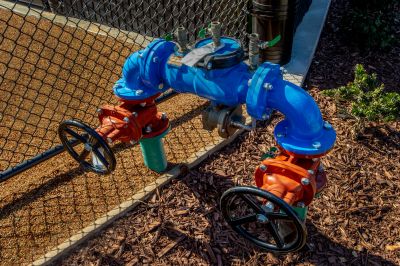Leading Backflow Prevention Devices for Efficient Installations
Discover the most popular backflow prevention solutions that offer durability, ease of use, and long-lasting performance.
 Backflow prevention is a critical component in plumbing systems, designed to prevent contaminated water from flowing back into the clean water supply. Proper installation and maintenance of backflow prevention devices are essential for ensuring water safety and compliance with local regulations. These products are used in various settings, including residential, commercial, and industrial applications, to safeguard potable water sources from potential pollutants.
Backflow prevention is a critical component in plumbing systems, designed to prevent contaminated water from flowing back into the clean water supply. Proper installation and maintenance of backflow prevention devices are essential for ensuring water safety and compliance with local regulations. These products are used in various settings, including residential, commercial, and industrial applications, to safeguard potable water sources from potential pollutants.
Top Overall Option
Universal Backflow Prevention Assembly
A versatile and durable backflow prevention assembly designed to accommodate a variety of system configurations. It features easy installation, reliable performance, and compliance with common plumbing standards, making it suitable for many applications. Its robust construction ensures longevity and consistent operation, serving as a dependable choice for maintaining water safety.
Types of Products For Backflow Installations
Double Check Valve Assembly
A device with two check valves to prevent backflow, commonly used in commercial and industrial settings.
Reduced Pressure Zone (RPZ) Assembly
A high-security device suitable for areas with higher contamination risks, featuring a relief valve for added protection.
Pressure Vacuum Breaker
A device that prevents back-siphonage by venting pressure from the system, often used in lawn irrigation.
Atmospheric Vacuum Breaker
A simple device that prevents backflow caused by siphoning, ideal for low-hazard applications.
Check Valves
Basic devices that allow water to flow in one direction, preventing backflow in small or localized systems.
Backflow Preventer with Test Ports
Devices equipped with test ports for easy inspection and testing to ensure proper operation.
Flanged Backflow Preventers
Heavy-duty devices designed for easy installation in larger piping systems with flanged connections.
Spring-loaded Check Valves
Valves with spring mechanisms that automatically prevent reverse flow, suitable for various pressure conditions.
Ball Valves for Backflow Control
Ball valves used in conjunction with other devices to control flow and facilitate maintenance.
Inline Backflow Preventers
Compact devices installed directly within piping to prevent backflow without requiring extensive modifications.
Dual Check Valves
Valves with two check mechanisms for enhanced backflow prevention, often used in residential systems.
Vacuum Breaker Assemblies
Assemblies designed to prevent siphonage, suitable for various plumbing applications.
Backflow Preventer Accessories
Additional components like test kits, repair kits, and mounting brackets to support maintenance and installation.
Popular Choices
Widely used in commercial settings for backflow prevention, offering reliable dual check mechanisms.
Commonly selected for high-risk areas requiring stringent backflow prevention.
Popular for irrigation systems to prevent back-siphonage during watering cycles.
Often used in low-hazard applications for simple backflow prevention.
Basic, essential devices for preventing reverse flow in localized plumbing sections.
Devices with accessible test ports for regular inspection, ensuring compliance and safety.
Compact and easy to install within existing piping systems for effective backflow prevention.
Suitable for larger systems requiring durable and secure connections.
Reliable in various pressure conditions, commonly used in industrial and commercial plumbing.
Versatile valves used to control flow and facilitate maintenance in backflow prevention systems.
Enhanced backflow prevention suitable for residential and light commercial applications.
Popular for preventing siphonage in various plumbing setups.
A wide range of products exists to meet different backflow prevention needs. From simple check valves to complex assemblies with multiple test ports, each type serves a specific purpose depending on the system's requirements. Selecting the right products involves understanding the system's pressure, flow rate, and potential contamination risks. Regular testing and maintenance are recommended to ensure these devices function effectively over time.
Installation quality and material durability are also important considerations. Materials such as bronze, stainless steel, and durable plastics are commonly used to withstand water pressure and environmental factors. Proper sizing and compatibility with existing piping systems help ensure seamless integration and long-lasting performance. Consulting local codes and standards can guide the correct selection and installation procedures.
Investing in reliable backflow prevention products contributes to the overall safety and integrity of water systems. Whether for new installations or retrofitting existing infrastructure, choosing the appropriate devices and maintaining them properly can help prevent costly water contamination issues. Always consider professional installation and periodic testing as part of a comprehensive backflow prevention strategy.
Key Buying Considerations
- Determine the type of backflow prevention device required based on system hazard level and local codes.
- Ensure compatibility with existing piping materials and sizes for proper installation.
- Check the device's pressure and flow rate ratings to match your system specifications.
- Assess whether the device includes test ports for easy inspection and compliance testing.
- Consider the material construction for durability and suitability to water conditions.
- Review installation requirements and space constraints to ensure proper fit and access.
- Verify certification standards and compliance with local plumbing regulations.
- Factor in maintenance needs and ease of servicing to ensure long-term effectiveness.
- Evaluate the device's connection type, such as flanged, threaded, or union, for compatibility.
- Look for devices with clear labeling and documentation for proper operation and testing.
- Consider whether the device is suitable for the intended application, whether residential, commercial, or industrial.
- Assess the availability of replacement parts and repair kits for ongoing maintenance.
- Determine if professional installation is recommended or required for compliance.
- Review customer feedback and product reviews for insights into performance and reliability.
- Budget considerations should include not only initial cost but also maintenance and testing expenses.
